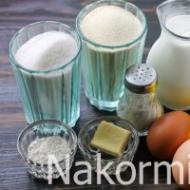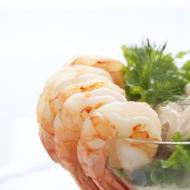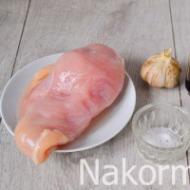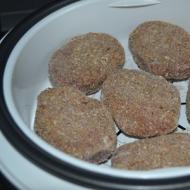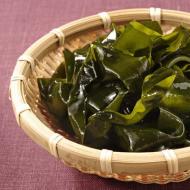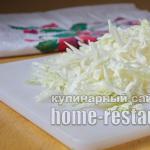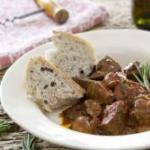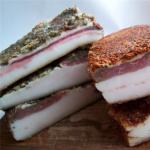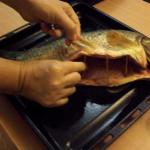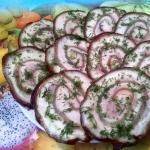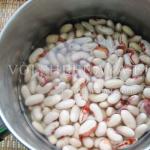
Horseradish recipe is a classic step-by-step recipe. Cooking table horseradish - the best recipes. With apples and sour cream
The most delicious dishes are made from freshly grated horseradish. Since it is not sold in its entire form in supermarkets, you should try to buy it at the market.
The most delicious dishes are made from freshly grated horseradish. Since it is not sold in its entire form in supermarkets, you should try to buy it at the market.
Horseradish grows almost everywhere except the far north. And already the ancient Egyptians learned to use it both for preparing various dishes and for medicinal purposes. Horseradish comes from the same family as radishes, daikon and radish - and these vegetables are famous for their metabolism-boosting properties.
Horseradish is not inferior to them. It activates digestion, improves intestinal function, and prevents excess food from being deposited in fat and clogging the body. Therefore, the role of horseradish in losing weight cannot be overestimated.
Important! Horseradish, like radishes, is contraindicated for problems with the liver and kidneys and inflammatory diseases of the stomach. Also, pregnant and lactating women should abstain from horseradish.
Preparation
You will have to peel the roots and immediately rub them (if you can stand it) or grind them in a meat grinder. To avoid crying over this insidious vegetable, you can try putting a plastic bag on the meat grinder.
Horseradish with sour cream
Grate 150 g of washed, peeled horseradish, 1/2 teaspoon of sugar, 100 g of sour cream, a little salt. Mix everything thoroughly and can be used as a sauce.
Horseradish spicy
The same ingredients as in the previous recipe, only we replace the sour cream with heavy cream and add grated almonds. Suitable as an appetizer for fish, vegetables, and meat.
Hungarian horseradish
Grate 2-3 large horseradish roots, boil them whole in the skins of 4-5 medium-sized beets, cool and also grate. Then add sugar (2 teaspoons), vinegar (2-3 teaspoons), salt to taste and a pinch of black pepper and cumin.
Stir and leave to brew for several hours. Served with meat, shish kebab, and smoked meats.
Hrenoder
200 g of ground or grated horseradish, 3-4 crushed garlic cloves, 2-3 fresh tomatoes ground in a meat grinder.
Add black pepper and salt to taste.
Canned horseradish
Wash and soak 1 kg of fresh horseradish roots for several hours, change the water at least twice. Peel and grind the horseradish in a meat grinder.
Bring 250 g of water to a boil, add half a tablespoon of sugar and salt, 20 g of citric acid. Pour the marinade into the ground horseradish.
It is advisable to immediately cover the dish with a lid - firstly, so that the vegetable does not dry out, and secondly, because of its vigor.
Place the prepared horseradish into prepared sterilized jars and close the lids tightly. Does not require any additional sterilization and can remain fresh for several years.
Sauerkraut with horseradish
Chop 5 medium heads of cabbage, grate 3 medium carrots. Prepare 1 large horseradish root - cut half of it into little finger-sized sticks, grate half of it. Wipe the inside of a small enamel pan well with grated horseradish.
Mix cabbage, carrots, horseradish, several small branches of dill, 5 tablespoons of salt, 3-4 bay leaves, 5 teaspoons of black pepper in a convenient bowl. Next, place the mixture into the pan, pressing it down with your fists as you go.
By the end of laying, liquid should appear on top of the cabbage. Cover the cabbage inside the pan with gauze, press it down with a plate on top, and place a weight (you can use a liter jar of water). Set aside in a warm place. After 3-4 weeks, sauerkraut with horseradish is ready to eat.
Horseradish for preparations
Place 200 g of ground or grated horseradish on the bottom of a 3-liter jar, cover with a cardboard circle with holes. Tomatoes and/or cucumbers are placed tightly on top of it, covered with a lid and put in a cool place. Horseradish will keep vegetables fresh for 2-3 months.
Any workpiece will not become moldy if you sprinkle it with dry crushed horseradish leaves on top. published
Preparing horseradish at home for the winter is an art! The season of pleasant chores and preparations for the winter has come. Vegetables and fruits have already been put away in the cellar, some in a barrel, some in jars, and some just sitting in boxes. It’s time to think about seasonings; you can’t live without them. One of the favorite and necessary seasonings in the winter is horseradish. After all, it gives some dishes an amazing, piquant taste, a certain zest.
What are the best ways to prepare this wonderful root for future use? The most famous and favorite preparation of horseradish for the winter is spicy traditional seasoning. After all, it goes well with all meat, fish and even vegetable dishes.
But harvesting is not only canning. But what about preparing horseradish for the winter without additives? Store it fresh, in boxes with sand, preferably in a cellar or basement, occasionally sprinkling with water. The root can be stored in this form until the next harvest.
And for those who love this vigorous root in canned form, there are several ways.
Canned horseradish - a recipe for preparing for the winter
Ingredients
- Horseradish roots – 1 kg;
- water – 20 ml;
- table vinegar 9% - 20 ml;
- salt, sugar – 30 g.
Preparation
Wash the horseradish roots and soak them in water for a day, then peel them thoroughly, scraping them with a knife. Next, clean roots need to be grated and poured with marinade. Boil water, add salt, sugar, and vinegar. Pour horseradish gruel with this solution, mix and pour into small sterilized jars, close.
Preparing horseradish at home
Ingredients
Preparation
Peel fresh horseradish roots, scrape them with a knife, and wash well in running water. Place a plastic bag over the neck of the meat grinder and take the smallest grate. Grind all the horseradish through a meat grinder, add salt and sugar, dilute with boiling water to obtain a paste and place in small jars. Add a few drops of lemon on top, but do not stir. Cover and store this snack in the refrigerator.
And calculate the amount of ingredients after all the horseradish has been rolled. From the amount of the resulting mass and dance. For example, if one and a half kilograms of mass came out of the meat grinder, then you will need 1 tbsp of salt. l. sugar – 3 tbsp. l. lemon juice.
Whatever method you use to prepare horseradish for the winter, you need to know one simple trick. Such preparations should be stored in a glass container with a tightly closed lid, so horseradish retains its sharp, vigorous taste.
I hope that preparing horseradish at home for the winter will become a good tradition in your country.
How to prepare horseradish for the winter?
Well, who doesn’t know that horseradish makes any dish, even if it’s not ideal, taste better? This wonderful seasoning for the winter is simple to make and unique in taste. Of course, it is easier to buy a ready-made additive for meat and fish dishes in a store. But homemade food is guaranteed to be healthy and harmlessly tasty.
The best punishment for a guilty husband is to force him to grate horseradish. And the tears will flow and flu prevention is effective, thanks to volatile, antibactericidal substances.
Traditional recipe: “White horseradish”
- 1 kg horseradish roots;
- 250 ml water;
- 4 tablespoons granulated sugar;
- 2 tablespoons salt;
- 2 tablespoons of vinegar essence or lemon juice.
- Drive the culprit of all misfortunes into the kitchen and force him to grate pure horseradish roots on a fine grater.
- If there is no reason for execution, put on swimming goggles.
- It is better to grate in a food processor.
- Mix with vinegar, salt and sugar.
- Close tightly and put in the refrigerator.
Red horseradish with beet juice
The beautiful color, familiar smell and pleasant pungency will delight lovers of the hearty Russian seasoning for the winter in cold times.
- 1 kilogram of horseradish;
- half a liter of beet juice;
- 30 grams of vinegar essence;
- 3-4 large spoons of granulated sugar;
- 2 tablespoons salt.
- Wash the roots thoroughly and slightly scrape off the outer skin.
- Place a tight bag over the meat grinder mouth and secure with an elastic band.
- Grind the horseradish.
- Mix with beet juice.
- Add sugar and salt, pour in the essence.
- Mix thoroughly and place in prepared, suitable-sized dishes.
- Cover with lids and sterilize in a water bath for about a quarter of an hour.
- Roll up and store.
You will find a recipe for adjika for the winter without cooking here.
Spicy seasoning “Ogonyok” for the winter
- 250 gr. horseradish roots;
- 3 kg of large, very ripe tomatoes, red varieties;
- 1 large spoon of sugar;
- 2 tablespoons of table salt.
- Grind the roots into a paste.
- Grind the garlic along with the tomatoes.
- Mix both purees.
- Add sugar and salt, mix.
- Place in a container and place in the refrigerator.
How to prepare horseradish for the winter according to all the rules
And it’s not only about the taste, to which not a single person will remain indifferent, but also about the amazing properties inherent in this inconspicuous root. Winter preparations with horseradish, very tasty!
Properly prepared horseradish for the winter helps improve digestion, helping the body cope with rich and fatty dishes, and has bactericidal, anti-inflammatory and restorative properties.
Horseradish is useful to add to food for the prevention of acute respiratory diseases, urolithiasis, joint inflammation and problems with potency.
A high-quality product should be no less than a finger thick, juicy and strong, without damage. It is very important to properly prepare horseradish for the winter, choosing the most suitable option for you.
Fresh storage.
Examine the roots carefully. Without regret, throw away horseradish with the slightest damage, cut off the tops. Shake the roots off the ground, place them in rows in a wooden box so that the roots do not touch each other and fill each row with sand - sifted and clean, without any impurities of earth or clay.
To keep the horseradish fresh, the sand must be slightly damp at all times, for which purpose it is evenly sprinkled with water once a week. The temperature should not be below 00C and rise above +40C.
Storing horseradish in the freezer in winter.
The roots need to be washed, peeled and cut into pieces suitable for grinding in a meat grinder. Now the horseradish can be put into plastic bags and placed in the freezer. Horseradish prepared in this way for the winter will retain all the beneficial qualities of the fresh root, and the taste will become even sharper.
Dried storage.
Dried horseradish is used in the preparation of various pickles so that the vegetables remain firm and the filling is tasty and transparent. To prepare the seasoning, wash the roots, grate them on a coarse grater and dry them in the oven without closing the door. After drying, the roots need to be ground in a coffee grinder.
How to cook horseradish for the winter
Of course, freshly prepared table horseradish is difficult to replace, but when guests arrive unexpectedly or a cold sets in, it can be difficult to do without a jar of pickled root.
Horseradish recipe for the winter:
Take fresh horseradish roots, wash and peel. In total, you should get 1 kg of peeled root, which needs to be soaked in water for a day. Now you can begin the most difficult operation - grinding horseradish in a meat grinder. Experienced housewives recommend putting a plastic bag on the meat grinder, this makes it much easier to deal with the pungent odor.
Then take one glass (250 ml) of water, boil it, dissolve one tablespoon of sugar and salt in it. Remove the solution from the stove and add 20 ml of citric acid or 125 ml of 6% vinegar, and then all the ground horseradish. Stir quickly and cover with a lid. That's it, the horseradish is ready for the winter! All that remains is to put it into jars.
This must be done quickly, filling and screwing each jar in turn. In total you will get one and a half kilograms of aromatic and, of course, “evil” seasoning!
Spicy hot horseradish, as a seasoning for dishes, especially fish and meat, is preferred by those who want it “hotter,” so to speak. Hot in our case is odorous, vigorous, burning to the point of tears. Horseradish is an old Russian seasoning. There are many methods for preparing it. You will learn some of them in this article.
Horseradish preparations
Making your own horseradish at home is quite simple. It is important to take care of the ingredients in advance, namely the roots, which need to be dug up in late autumn. They ideally grow to 40-50 centimeters, and reach 4-5 centimeters in diameter. These roots are considered the most suitable for making horseradish. But to prevent it from “fizzle out” and lose its properties, it should be placed in a fairly damp and cool place. Then you can use these roots little by little for cooking. But there are people who immediately prepare this seasoning for the whole winter and often end up losing. In order for horseradish to retain its properties in canned form, you cannot do without chemicals. Homemade horseradish can retain its pungency for no longer than a month, and only on condition that it is in a tightly sealed jar that is kept in the refrigerator. So make this snack little by little.
Even if the roots are stored in a humid room, they still dry out. Therefore, before preparing horseradish, you need to thoroughly rinse the roots and then put them in cold water, which needs to be changed every day. The soaking time should be from 2-3 days to a week, it depends on their condition. When the roots soften and swell a little, you can remove them, peel them, and then grate them on a fine grater or pass them through a meat grinder. This process is not pleasant, since horseradish burns the nasopharynx and eats away the eyes. Therefore, cooks use protective equipment. In addition, you need rubber gloves if you do not want to burn your palms and/or fingers.
Horseradish recipes
Recipe 1
Wash and peel the horseradish roots thoroughly. Place the bag tightly on the meat grinder, tying it to the socket. Use a fine grinder rack. For 1.5 kg of grated horseradish you need: 3 tbsp. sugar and tbsp. salt. Then pour boiling water into the horseradish so that a thick porridge comes out, mix everything quickly and put it in sterilized jars. Add a couple drops of lemon juice on top. Serve this horseradish with fish and meat separately or mixed with sour cream. If you close the lid tightly, it can be stored in the refrigerator for more than 3 months.
Recipe 2
This recipe will help you make truly vigorous horseradish. Take: sugar, salt, 3 large horseradish roots, 3 cloves of garlic and 1 kg of tomatoes. Peel the tomatoes, garlic and horseradish, then grind in a meat grinder or blender. If you use a meat grinder, then twist the horseradish into a tied bag, as it really hurts your eyes. Salt it all, add sugar and stir. Store in sterilized jars. It will taste much better if it sits in the refrigerator for a day.
Recipe 3
Most people serve horseradish pink. It's easy to do and looks beautiful. This is done by adding beets. For 300 gr. roots need 2 tbsp. beet juice, tbsp. salt and sugar, 100 gr. 9% vinegar, 150 gr. water. First, the horseradish roots must be thoroughly washed and peeled. Then grate the roots on a fine grater, but it is better to pass them through a meat grinder. Don't forget about a bag that can protect your eyes and nose. Pour boiling water over the ground horseradish, add sugar and salt and leave to cool. Add beet juice, which is made from boiled vegetables, and vinegar to cold horseradish. Store this horseradish in sterile jars.
In our country, horseradish is a fairly common plant and is known primarily as a spicy addition to a wide variety of dishes. But this root is quite capable of acting as the main ingredient. For example, a very popular sauce is prepared on its basis - horseradish seasoning, which can add piquancy to many fish and meat snacks.
A little about the seasoning itself
Horseradish, which is the main component of our seasoning, is a very healthy root. It increases appetite, tones the body and activates energy. A few small jars of this sauce can serve you well. And in order to prepare it, you need to follow a few simple rules.
Cooking Basics
- Horseradish, which was collected in late autumn, is considered the most suitable for seasoning.
- Select large roots, the length of which is at least 30 cm and the diameter of no more than 6 cm.
- Before cooking, it is advisable to soak the horseradish in cool water and let it sit for three to six hours.
- Next, we clean the roots, wrap them in cling film and put them in the freezer for about an hour.
On a note! These procedures will help prevent the discomfort that usually occurs when chopping horseradish - your eyes will not water!
- After you have passed the roots through a meat grinder or grated them, you need to add a little lemon juice or vinegar to the mass.
- Next, place the prepared horseradish in small jars or plastic containers.
With beet juice
To prepare you need to take:
- a kilo of horseradish roots;
- half a liter of beet juice;
- 1 tables. a spoonful of vinegar essence;
- half a glass of sugar;
- 3 tables. spoons of salt.
Prepare the seasoning: wash the horseradish roots thoroughly, peel them and grind them using a meat grinder. We grate the beets on a fine grater, squeeze out the crushed mass, and add the resulting juice to the horseradish that we twisted. Then add vinegar, sugar and salt. Mix everything thoroughly. Place the resulting seasoning in jars and sterilize for 15 minutes if the jar is half a liter, and sterilize a liter jar for 20 minutes.
With apple
For the recipe for horseradish and apple seasoning, take the following ingredients:
- kilo of apples;
- 0.15 kg horseradish;
- 0.15 kg garlic;
- 5 ml of vinegar essence;
- 15 g salt;
- 20 g sugar.
We soak the roots in cold water for three hours, after which we remove the peel from them. We also peel the apples. Grind the prepared ingredients. We free the garlic from the husk and pass it through a press.
Combine all prepared products in a large bowl. Add salt, add sugar, add vinegar essence and mix well. Place the seasoning in small clean jars, cover with lids and place in a water bath. Let stand for five minutes, then close tightly and put in a cool place for storage.
With carrots
For the recipe we take:
- 0.15 kg horseradish;
- 0.3 kg carrots;
- 5 g paprika;
- 5 g white pepper;
- 10 g salt;
- 5-7 g sugar;
- half a glass of water;
- 55-60 ml vinegar.
Add vinegar to the mixture, add sugar, paprika, pepper and salt.
On a note! If white pepper is not available, then in this recipe it can be replaced with black!
Mix everything thoroughly and place in sterilized jars. Close tightly and store in a cool place.
With garlic and tomatoes
For horseradish seasoning with garlic and tomatoes, take:
- 0.2 kg horseradish;
- 0.2 kg of tomatoes;
- 0.1 kg garlic;
- 15 g salt;
- 15 g sugar;
- 45-50 ml vinegar;
- 90 ml vegetable oil.
Blanch the tomatoes in boiling water for 30 seconds, then peel them and pass them through a meat grinder. Add sugar to the tomato mass, add salt and place on the stove. With a small gas supply, boil for 20 minutes. About five minutes before the end of cooking, add the oil and crushed garlic.
We clean the roots, grate them on a fine grater and place them in the boiling tomato mass. Add vinegar and immediately after boiling remove from heat. Place in sterilized jars and seal with lids.
“Ogonyok” with chili pepper
For the recipe we take:
- 0.1 kg of roots;
- kilo of tomatoes;
- 10-12 cloves of garlic;
- chili pepper pod;
- a couple of tables. spoons of salt.
On a note! It is better to remove the seeds from the chili, otherwise the seasoning will turn out too strong!
Mix the ingredients and add crushed garlic. Salt, add sugar. Place the seasoning in clean jars and seal.
With bell pepper
For the dish you will need:
- 0.1 kg of hot root vegetable;
- 0.3 kg bell pepper;
- 4-5 cloves of garlic;
- 15 g sugar;
- 20 g salt;
- a couple of tables. spoons of lemon juice.
Wash the horseradish, peel and peel it. We remove the seeds from the sweet pepper pods and cut off the stalks. We twist the products in a meat grinder.
Add crushed garlic to the resulting mass, pour in lemon juice, salt and add sugar. Mix everything and distribute into sterilized jars. Cover tightly with lids and store in a cool place.
With oranges
Horseradish seasoning with orange juice is prepared from the following products:
- 0.1 kg horseradish;
- a couple of oranges;
- 45 ml dry white wine;
- 2-3 g salt.
With sour cream
For the recipe we take:
- 0.3 kg of burning roots;
- 200-220 ml sour cream;
- 30 g sugar;
- 2-3 g salt.
We clean the roots and pass them through a meat grinder. Salt, add sugar. Mix everything and add sour cream to the mixture.
On a note! If you think that the seasoning is too thick, you can dilute it a little with chilled boiled water.
Transfer the mixture into a jar, close tightly and put it in the refrigerator for a couple of hours. Since this seasoning does not last long, it is advisable to use it quickly - within two days.
Obviously, making horseradish seasoning at home is as easy as shelling pears. Therefore, do not rush to buy a store-bought product - it’s better to make it yourself. After all, this way you will be completely confident in its quality.
Bon appetit!
All materials on the website are presented for informational purposes only. Before using any product, consultation with a doctor is MANDATORY!
Chief Editor
Horseradish is rightfully considered a storehouse of useful enzymes. The root of the plant is characterized by an intense aroma that “hits” right in the nose. Many people love horseradish for its sweet aftertaste, which later becomes hot. Grated horseradish root is added to the first and second courses; many people prefer to use the sauce along with a slice of baguette. Horseradish contains a lot of vitamins, including rare groups PP, B, A, D, and amino acids. To enjoy all the beneficial properties, we will consider important aspects and basic recipes for preparing horseradish at home.
Cooking horseradish: important features
It is not difficult to prepare horseradish at home if you follow important aspects. Make sure you have the plant root and prepare it in advance.
- Raw materials are dug out in late October or early November. As a rule, horseradish grows up to 35-40 cm, in some cases more. In this case, the diameter of the plant reaches 3-5 cm. It is the listed characteristics that indicate that the root is suitable for pickling.
- To ensure that horseradish retains its properties after collection and does not erode, place the root in a cool place with sufficient humidity. Take a certain amount of the composition as needed, without violating storage conditions.
- Not many people know that horseradish retains its beneficial qualities and characteristic pungency only during the first month. This feature is achieved by a completely natural composition. To increase the effect, you will have to use chemicals.
- Get into the habit of preparing pickled horseradish in small portions. You should not stock up on the product for future use. After combining all the ingredients, transfer the canned mixture to a container or jar and store in the cold.
- Even when the roots are kept in a humid room, they still dry out. For this reason, before you start cooking, wash the roots, then soak them in cold water. Change the fluid 2 times daily. The duration of soaking is 3-7 days.
- When the horseradish becomes soft and swells a little, remove and peel it. Grate on a very fine grater or use a food processor/blender/meat grinder. Be prepared for the process itself to be unpleasant. Horseradish will burn your throat, nose, eyes.
- To avoid burning your skin, wear rubber gloves when working with horseradish. Protect your respiratory tract with a medical mask and your eyes with goggles. To prevent chopped horseradish from starting to darken, it is sprayed with table vinegar (6% concentration) or lemon juice.
- Before preparing horseradish seasoning, place the root of the plant in the freezer for half an hour. This move will save you from the difficulties with well-being that usually arise when working with a nuclear composition.
- If you still have horseradish roots after preparing the seasoning, try increasing their shelf life. Prepare a container for microwave or food, fill it with water, place the plants inside. Change the fluid every day.

- table vinegar solution (9%) - 145 ml.
- horseradish root - 385 gr.
- granulated sugar - 25 gr.
- table salt - 35 gr.
- beet juice - 60 ml.
- drinking water - 180 ml.
- Soak the roots of the plant in water according to the general rules. After this, wash the horseradish well with a table sponge, remove the peel, and grate it. Pour boiling water over the mixture and wait 5 minutes.
- After this, add sugar, salt, wait until it cools completely (about 40 minutes). Squeeze the juice from the beets to obtain 2 tablespoons of the mixture.
- Mix beet juice with table vinegar, pour the mixture into the soaked horseradish. There is no need to pour out the cooled water; it serves as brine for long-term storage.
Tomato horseradish
- horseradish root - 500 gr.
- fresh tomatoes - 2.8 kg.
- garlic - 200 gr.
- salt - 85 gr.
- sugar - 80 gr.
- Peel the horseradish roots, soak in ice water, and leave for 4 hours. After this, chop the product into equal pieces, grind in a blender or pass through a meat grinder. You can use a grater, use your discretion.
- Wash the tomatoes, make a cross-shaped cut on each tomato, and scald with boiling water. Wait 1 minute, peel and remove stems. Scroll the tomatoes in a meat grinder 2 times, mix with garlic, passed through a press.
- Combine all ingredients into a homogeneous mass and blend again with a blender. Season with salt, sweeten, and add ground pepper and bay leaf if desired. Pack the finished composition in sterilized glass containers.
- Store in the refrigerator for no longer than two months in the case of rolled up products, and about 30 days for sealed products. If possible, consume horseradish in the first two weeks so that it does not lose its beneficial properties.
Horseradish with cinnamon
- filtered water - 480 ml.
- table vinegar (9%) - 55 gr.
- horseradish root - 600 gr.
- sugar (preferably brown) - 45 gr.
- table salt - 25 gr.
- cloves - 4 buds
- cinnamon - to taste
- Wash the horseradish with a kitchen sponge, remove the peel and grate it on a fine grater (you can grind it in a blender or meat grinder). Prepare a sterile glass container and package the horseradish in it.
- In another bowl, mix sugar and salt, add filtered water. Pour the mixture into a saucepan, put on fire and bring until the first bubbles appear.
- When the granules are completely dissolved, add the clove buds and cook the mixture for 3 minutes. Cover the container with a lid and let the solution cool at room temperature.
- When the mixture has cooled to 55 degrees, pass it through a filter and add cinnamon. Pour in table vinegar, seal and wait 20 hours. After this, pour the solution into the horseradish, roll up the jars, and transfer to the cellar.

- olive oil - 40 ml.
- green apple - 1 pc. large size
- meat broth (pork-beef) - 135 ml.
- horseradish (root) - 110 gr.
- apple cider vinegar - 40 ml.
- fresh parsley - 1 bunch
- sugar - to taste
- salt - to taste
- Wash the horseradish and remove the peel. Do the same with the apple: remove the stem and seeds. Grind the products until smooth by passing them through a blender or grater.
- Wash a bunch of parsley, chop it, pour in the vinegar solution and chicken broth. Combine all ingredients, add olive oil, sugar, salt, leave the mixture to steep for 3 hours.
- Apple seasoning is distinguished by its mild composition, for this reason people with gastrointestinal diseases love it. The sauce is aromatic, not too spicy, and pleasant to the taste.
- Serve apple relish in small gravy boats. Garnish with a leaf of fresh parsley or dill. Some housewives prefer to add grated olives to the above composition.
Horseradish with sour cream
- horseradish root - 285 gr.
- sugar - 25 gr.
- sour cream - 190-200 gr.
- fresh dill - 20 gr.
- fresh parsley - 10-15 gr.
- The recipe is intended for the category of citizens who cannot stand too spicy horseradish sauce. Drench the roots of the plant with water, remove dirt with a sponge, and remove the peel.
- Pass the horseradish through a meat grinder or blender to obtain a paste. Add chilled high-fat sour cream (25% or more), stir, and refrigerate for 2 hours.
- During this period, wash and completely dry the dill and parsley, mix the herbs with sugar. If desired, add 3 cloves of garlic, passed through a press.
- Remove the horseradish from the refrigerator, mix with other ingredients, and roll into jars. The storage time in the cellar is 20 days; if possible, consume the product as quickly as possible.

- horseradish root - 300 gr.
- honey (can be replaced with cane sugar) - to taste
- salt - to taste
- lemon zest (fresh) - 45 gr.
- sour cream - in fact
- Rinse the horseradish root, peel off the skin with a knife, grate it to form thin plates (as is the case with pickled ginger).
- Prepare small glass jars, sterilize them, and fill them 3 cm with ice-cold filtered water. Place chopped horseradish into the cavity, add sugar and salt.
- Seal the lids and shake each container until the mixture is mixed. Grate the lemon peel and, if desired, add citrus juice (amount at your discretion).
- Leave the horseradish to steep in the refrigerator for 1 hour. Before serving, brush the product with sour cream to give the product a creamy taste. Use within a week, otherwise horseradish will lose its beneficial properties.
- To make the snack rich, store the finished product in glass jars. If possible, wrap containers in a dark bag to prevent light from entering.
- The harvested crop is stored in wooden containers with sand. In this case, the roots are positioned in such a way as to completely eliminate their contact with each other. Once a week it is necessary to water the composition with drinking water.
- Traditionally, horseradish is consumed with meat dishes (pork, beef, lamb). The seasoning also serves as an excellent addition to jellied meat, smoked fish, mince pies, jelly, knuckle, sturgeon jellies and suckling pig.
Making horseradish at home is quite simple. Consider cooking recipes with the addition of tomatoes, cinnamon, full-fat sour cream, vinegar, and green apples. Add your favorite seasonings, lemon zest, and fresh herbs. Serve pickled horseradish root with meat and fish dishes, as well as jellied meat.
Video: homemade version of horseradish preparation

